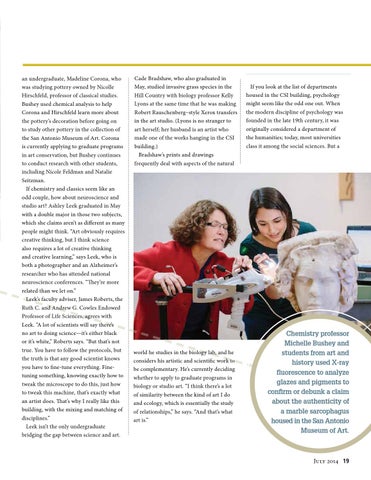an undergraduate, Madeline Corona, who was studying pottery owned by Nicolle Hirschfeld, professor of classical studies. Bushey used chemical analysis to help Corona and Hirschfeld learn more about the pottery’s decoration before going on to study other pottery in the collection of the San Antonio Museum of Art. Corona is currently applying to graduate programs in art conservation, but Bushey continues to conduct research with other students, including Nicole Feldman and Natalie Seitzman. If chemistry and classics seem like an odd couple, how about neuroscience and studio art? Ashley Leek graduated in May with a double major in those two subjects, which she claims aren’t as different as many people might think. “Art obviously requires creative thinking, but I think science also requires a lot of creative thinking and creative learning,” says Leek, who is both a photographer and an Alzheimer’s researcher who has attended national neuroscience conferences. “They’re more related than we let on.” Leek’s faculty adviser, James Roberts, the Ruth C. and Andrew G. Cowles Endowed Professor of Life Sciences, agrees with Leek. “A lot of scientists will say there’s no art to doing science—it’s either black or it’s white,” Roberts says. “But that’s not true. You have to follow the protocols, but the truth is that any good scientist knows you have to fine-tune everything. Finetuning something, knowing exactly how to tweak the microscope to do this, just how to tweak this machine, that’s exactly what an artist does. That’s why I really like this building, with the mixing and matching of disciplines.” Leek isn’t the only undergraduate bridging the gap between science and art.
Cade Bradshaw, who also graduated in May, studied invasive grass species in the Hill Country with biology professor Kelly Lyons at the same time that he was making Robert Rauschenberg–style Xerox transfers in the art studio. (Lyons is no stranger to art herself; her husband is an artist who made one of the works hanging in the CSI building.) Bradshaw’s prints and drawings frequently deal with aspects of the natural
world he studies in the biology lab, and he considers his artistic and scientific work to be complementary. He’s currently deciding whether to apply to graduate programs in biology or studio art. “I think there’s a lot of similarity between the kind of art I do and ecology, which is essentially the study of relationships,” he says. “And that’s what art is.”
If you look at the list of departments housed in the CSI building, psychology might seem like the odd one out. When the modern discipline of psychology was founded in the late 19th century, it was originally considered a department of the humanities; today, most universities class it among the social sciences. But a
Chemistry professor Michelle Bushey and students from art and history used X-ray fluorescence to analyze glazes and pigments to confirm or debunk a claim about the authenticity of a marble sarcophagus housed in the San Antonio Museum of Art.
July 2014 19
